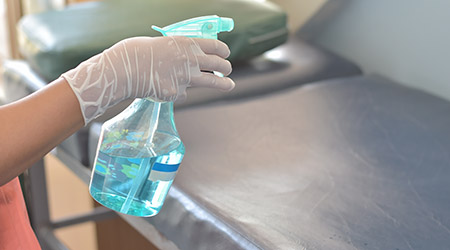Increasing numbers of hospital-acquired infections (HAI) have generated much attention over the last two decades. The public has linked the so-called superbugs with their experience of dirty hospitals, but the precise role of cleaning in the control of these organisms is unknown. Hence, the importance of a clean environment is likely to remain speculative unless it becomes an evidence-based science.
Hospital patients can acquire organisms from many sources, including the environment, but the extent to which the latter contributes to HAIs is largely unknown. This is because cleaning has never been regarded, let alone investigated, as an evidence-based science.
Despite the lack of evidence, the hospital environment might well act as a significant reservoir for potential pathogens. A favorable niche can quickly be found and retained, unless disturbed by some appropriate cleaning or disinfection process. This reservoir then can be extended by vectors such as air turbulence, aerosolized moisture, an unwashed hand, or direct contact with an inanimate object, equipment, or material. The hands of healthcare workers might represent the final mode of transmission, but even exemplary hand hygiene cannot be expected to break the chain of infection when the environment is heavily contaminated.
Cleaning has two main functions. The first is non-microbiological to improve or restore appearance, maintain function, and prevent deterioration. The second is microbiological to reduce the numbers of microbes present, together with any substances that support their growth or interfere with disinfection/sterilization. So the term cleaning can be interpreted in different ways. But patients and their relatives expect a clean uncluttered environment in hospitals. They criticize hospitals they consider dirty and associate them with a general lack of care. Such consumer demands for cleaning aesthetics cannot be disputed.
As cleaning could be a cost-effective method of controlling HAIs, it should be investigated as a scientific process with measurable outcome.
To achieve this, it is necessary to adopt an integrated and risk-based approach. This includes preliminary visual assessment, rapid sensitive tests for organic deposits and specific microbiological investigations. Such an approach already has been established by the food industry to manage cleaning practices in a cost-effective manner and is described elsewhere.
The finding of 5 CFU or more per square centimeter from a hand contact surface, whatever the identity of the organisms, indicates there might be an increased risk of infection for the patient in that environment. This should generate an evaluation of the cleaning and disinfection practices and frequencies for that surface. This is based on three suppositions:
- An increased microbial burden suggests that there has been insufficient cleaning. This would increase the chances of finding a pathogen.
- A heavy microbial burden may mask the finding of a pathogen.
- A heavy concentration of certain organisms implies an increased chance of finding an epidemiologically related pathogen, e.g., coagulase-negative staphylococci and S. aureus. This surmise forms the basis of WHO standards regarding water quality. Repeat sampling should follow a risk evaluation, whether there has been a change in practice.
With the increasing tide of antibiotic resistance, basic hygiene practices may be all we have left. Microbes other than bacteria have not been included in the standards, but additional pathogens that could be considered as indicator organisms would be norovirus, rotavirus and the recently identified coronavirus linked with SARS-COVID-19. Hopefully, further work will provide the evidence required to promote and evaluate hospital cleaning for the benefit of patients now and for the future.
J. Darrel Hicks, BA, MESRE, CHESP, Certificate of Mastery in Infection Prevention, is the past president of the Healthcare Surfaces Institute. Hicks is nationally recognized as a subject matter expert in infection prevention and control as it relates to cleaning. He is the owner/principal of Safe, Clean and Disinfected. His enterprise specializes in B2B consulting, webinar presentations, seminars and facility consulting services related to cleaning and disinfection. He can be reached at darrel@darrelhicks.com or you can learn more at www.darrelhicks.com.

 Building Sustainable Healthcare for an Aging Population
Building Sustainable Healthcare for an Aging Population Froedtert ThedaCare Announces Opening of ThedaCare Medical Center-Oshkosh
Froedtert ThedaCare Announces Opening of ThedaCare Medical Center-Oshkosh Touchmark Acquires The Hacienda at Georgetown Senior Living Facility
Touchmark Acquires The Hacienda at Georgetown Senior Living Facility Contaminants Under Foot: A Closer Look at Patient Room Floors
Contaminants Under Foot: A Closer Look at Patient Room Floors Power Outages Largely Driven by Extreme Weather Events
Power Outages Largely Driven by Extreme Weather Events